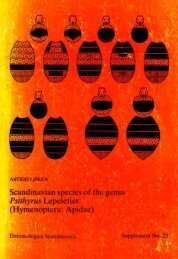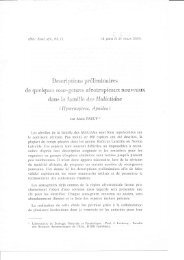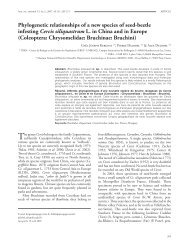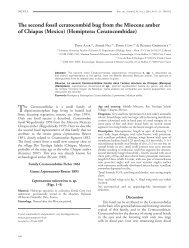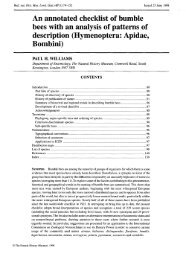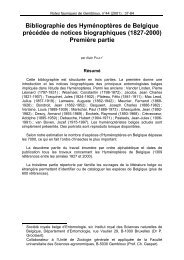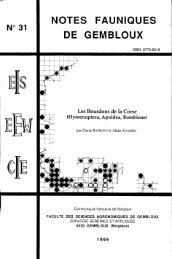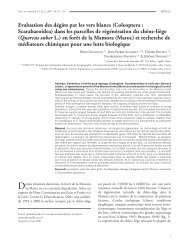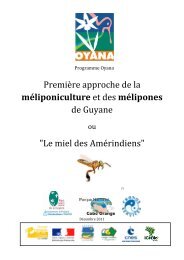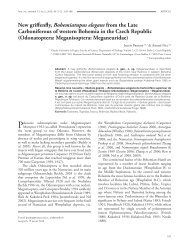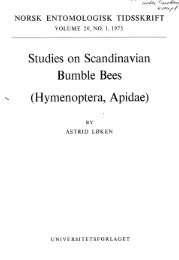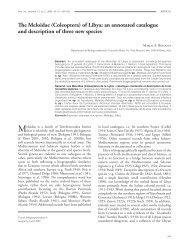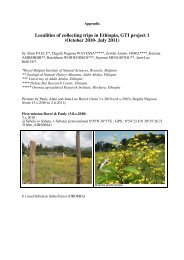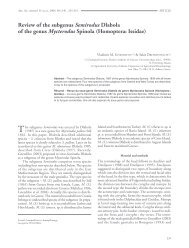Préférence des reines vierges de Bombus terrestris - Laboratoire de ...
Préférence des reines vierges de Bombus terrestris - Laboratoire de ...
Préférence des reines vierges de Bombus terrestris - Laboratoire de ...
Create successful ePaper yourself
Turn your PDF publications into a flip-book with our unique Google optimized e-Paper software.
T. Mathy – <strong>Préférence</strong> intraspécifique <strong><strong>de</strong>s</strong> <strong>reines</strong> <strong>de</strong> <strong>Bombus</strong> .<strong>terrestris</strong> pour les sécrétions céphaliques – Page 67<br />
Djegham Y, 1991. Etu<strong>de</strong> du comportement sexuel en captivité <strong>de</strong> <strong>Bombus</strong> <strong>terrestris</strong> auct. (Hymenoptera,<br />
Apidae). Mémoire <strong>de</strong> fin d’étu<strong><strong>de</strong>s</strong>, Université <strong>de</strong> Mons-Hainaut, Mons, 63 p.<br />
Djegham Y., J.-C. Verhaeghe & P. Rasmont, 1994. Copulation of <strong>Bombus</strong> <strong>terrestris</strong> L. (Hymenoptera:Apidae)<br />
in captivity. Journal of Apicultural Research, 33(1): 15-20.<br />
Dobzhansky T, 1970. Genetics of the evolutionary process. Columbia University Press, New York, 505 p.<br />
Farkas S.R., H.H. & Shorey , 1972. Mechanisms of orientation to a distant pheromone sources, in pheromone,<br />
Journal of Chemical Ecology, 8: 1207-1215.<br />
Free J.B, 1970. Stimuli electing mating behaviour of bumblebee (<strong>Bombus</strong> pratorum (L.)) males. Behaviour,<br />
40(1-2): 55-61.<br />
Free J.B & C.G Butler, 1959. Bumblebees. The Macmillan Company, New York, 208 pp.<br />
Groth I., 1984. Male marking pheromones in North European Cuckoo Bumble Bee Psithyrus (Hymenoptera,<br />
Apidae). Nova acta Regiae Societatis Scientiarium Upsaliensis, Serie V, 3: 161-166.<br />
Goka K, 1998. Influence of invasive species on native species—will the European bumble bee, <strong>Bombus</strong><br />
<strong>terrestris</strong>, bring genetic pollution into the Japanese native species? Bulletin Biogeographical Society<br />
Japan, 53: 91–101.<br />
Gorez M., 2007. Electro-antennographie <strong>de</strong> <strong>reines</strong> <strong>vierges</strong> <strong>de</strong> <strong>Bombus</strong> <strong>terrestris</strong> (L.) (Hymenoptera, Apidae)<br />
vaporisées par <strong><strong>de</strong>s</strong> sécrétions céphaliques mâles. Mémoire <strong>de</strong> fin d’étu<strong><strong>de</strong>s</strong>, Université <strong>de</strong> Mons-<br />
Hainaut, Mons, 70 p.<br />
Erlandsson S., 1979. <strong>Bombus</strong> canariensis Pérez 1895 n.stat & <strong>Bombus</strong> ma<strong>de</strong>rensis n.sp. from the Macronesian<br />
Islands. Entomologia Scandinavia, 10: 1427-1431.<br />
Estoup A., M. Solignac, J.M. Cornuet, J. Gou<strong>de</strong>t & A. Scholl, 1996. Genetic differentiation of continental<br />
and island population of <strong>Bombus</strong> <strong>terrestris</strong> (Hymenopera Apidae) in Europe. Molecular Ecology, 5: 19-<br />
31<br />
Fraenkel G.S. & D.L. Gunn, 1940. The orientation of animals. Clarendon Press, Oxford.<br />
Haas A., 1949. Arttypische Flugbahnen von Hummelmännchen. Zeitschrift für vergleichen<strong>de</strong> Physiologie, 31:<br />
281-307.<br />
Haas A., 1967. Vergleichen<strong>de</strong> Verhaltensstudien zum Paarungsschwarm <strong>de</strong>r Hummeln (<strong>Bombus</strong>). Zeitschrift für<br />
Tierpsychologie, 257-277.<br />
Hines H, S. Cameron & P. Williams, 2006. Molecular phylogeny of the bumble bee subgenus Pyrobombus.<br />
(Hymenotera: Apidae: <strong>Bombus</strong>) with insights into gene utility for lower-level analysis. Invertebrate<br />
systematics, 20: 289-303.<br />
Hohmann H., F. La Roche, G. Ortega, & J. Barquin, 1993. Bienen, Wespen und Ameisen <strong>de</strong>r Kanarischen<br />
inseln (Insecta: Hymenoptera: Aculeata). Übersee-Museum, Bremen, 894 p.<br />
Inari N. T. Nagamitsu, T. Kenta, K. Goka & T. Hiura, 2005. Spatial and temporal pattern of introduced<br />
<strong>Bombus</strong> <strong>terrestris</strong> abundance in Hokkaido, Japan, and its potential impact on native bumblebees. The<br />
Society of Population Ecology and Spring-Verlag Tokyo, 44: 77-82.



